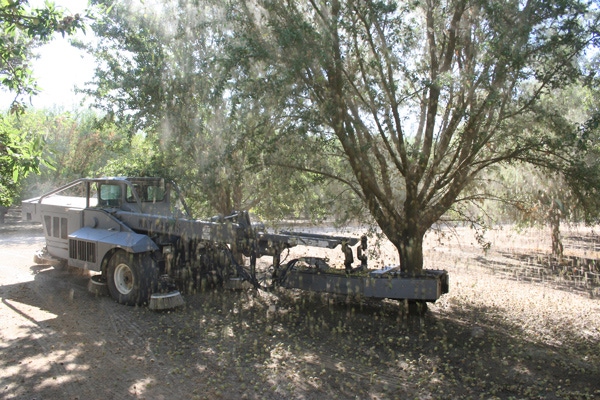September 16, 2015

An earlier almond harvest, coupled with a fourth year of drought, is resulting in smaller kernels in some regions as California almond growers scurry to harvest a crop estimated at 1.8 billion pounds, down 4 percent from last year.
In late August, harvest was about 12 days earlier than usual, said David Doll, a University of California pomology farm advisor in Merced County.
On the plus side, Doll said younger orchards coming into production are helping to sustain some operations since many are high producers in the 500-to-600-pound range per acre and even as high as 1,000 pounds in third leaf. And kernels from those younger blocks size well.
Doll said the industry nonetheless is undergoing a “natural disaster” due to the drought, and he finds it wrenching to see the setbacks some farmers face, particularly if they don’t have the means to sink new wells or take other steps to sustain their crop.
“It’s sometimes the difference between the haves and have-nots,” he said. “Some prepared and had strategies - others did not.”
“There’s an orchard in Merced that has a zero allocation of water,” Doll said. “The grower is essentially watching his trees die out.”
The sustained drought, he adds, is having an accumulative effect, especially as growers rely on groundwater higher in salinity that builds in the soil. Applying less water means less vegetative growth.
“Last year’s lack of growth impacted this year, and this year’s will impact next year,” Doll said. “It reduces the number of fruiting positions.”
Bill Chandler, who grows almonds in the Parlier area, is starting to see the effects of some salinity.
“We haven’t had water to leach salts past the root zone, - just not enough winter rain,” he said.
Doll pointed out that higher salinity amounts to a double whammy. It increases stress which hampers the flow of water.
“It makes the tree work harder for water,” he said.
Over time, levels can rise to cause toxicity including leaf scorch, burn, and drop.
Like many growers who rely increasingly on well water, Chandler has relocated one well for farming, found drillers “pretty busy,” and Pacific Gas and Electric Company faces a backlog on inspections for new wells.
But Chandler said the harvest in his orchard “is coming along real good. Everything is drying fast.”
The earlier harvest has its up sides, says Frank Roque, a principal with Panoche Creek Packing in Kerman.
“We’re moving right through (the harvest), and it looks like we won’t have down time between varieties,” he said, adding that, with an El Nino predicted, it will be good to have the nuts out of the orchard earlier to guard against rain damage.
Roque said the Nonpareil variety, an industry mainstay, appears to be off by 15 percent to 20 percent in yield.
Mike Kelley, president of the Central California Almond Growers Association, a Kerman huller-sheller, said kernel sizes started very small – “pee-wees” – and “the coloration didn’t look good,” but sizes have increased as harvest progresses.
“We’re cautiously optimistic things are starting to improve,” he said.
Kelley said he estimates yields could be off 10 percent.
“But the price of almonds has gone so high compared to last year that it will offset losses. It’s at $4.60 a pound. Last year it was a dollar less.”
The accumulative effects of the drought, resulting in two crops that fell short of recent bumper years, means “we can’t meet the demand that’s out there,” Kelley said.
Firebaugh grower Chester Andrew believes the USDA-NASS estimate of 1.8 billion pounds is “pretty close.”
“The crop isn’t as big,” he said. “Statewide, it may be lighter than that. It was at 2,200-2,500 pounds per acre in the past. We’re getting 1,800 pounds per acre. It’s off about 20 percent.”
He blames lower yields in part on inadequate chilling hours, and said younger orchards are doing “very well - anything 15 years or older is definitely off.”
Kern County grower Kent Stenderup also says a “lack of dormant weather” has posed a problem.
“In recent years, we’ve not had the cold, foggy winter days when the leaves come down and the trees can sleep for a while,” he said. “We had leaves on the trees in January.”
Stenderup said Navel orangeworm pressures are also high this year.
Stenderup has lowered several wells and changed his cropping system, foregoing some double cropping to redirect water to his almonds.
“We’re not in the dire straits a lot of people are,’’ he said.
Stuart Woolf, president of Woolf Farming, said his company, which farms on the west side of Fresno County, has fallowed nearly 6,000 acres of row crops and is looking at crop rotations including onions, garlic, and processing tomatoes.
Woolf is a principal in a tomato processing company, he says, so it makes sense to have significant tomato acreage, but it may be necessary to adjust the amount of acreage going to other row crops.
He is also a principal in an almond processing plant.
Earlier this year, Woolf said the company pulled out 190 acres of older trees and expects to pull still more within a year or so.
“It’s important to decide where to use the last drop of water,” he said, adding that it may make sense to pull out older orchards five years earlier than would have been done in times when they were not facing the challenges of drought.
About the Author(s)
You May Also Like




